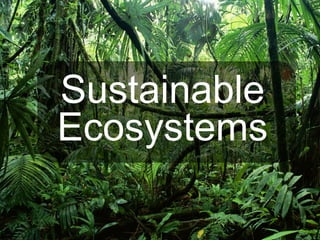
Earth's Sustainable Ecosystems
- 2. Earth is a medium-sized planet orbiting a star (the Sun) at a distance of approximately 150,000,000 km Viewed from space, Earth appears as a pale blue dot. Earth
- 3. As you near Earth, you will notice it is surrounded by a thin gaseous layer swirling with clouds.
- 4. Finally, you will be able to distinguish the oceans, land and ice that cover the Earth’s surface.
- 5. Earth’s atmosphere is the layer of gases extending upward for hundreds of kilometers. The Atmosphere
- 6. The Atmosphere The atmosphere is made up of about 78% nitrogen gas and 21% oxygen gas. The remaining <1% of the atmosphere includes argon, water vapour, carbon dioxide and a variety of other gases.
- 7. The Atmosphere The atmosphere is critical to life on Earth. It acts like a blanket and moderates surface temperatures. The insulation prevents excessive heating during the day and cooling during the night.
- 8. The Atmosphere The Earth’s global average surface temperature is 15o C. Without an atmosphere, the global average surface temperature would be -18o C
- 9. The Atmosphere Earth’s atmosphere also blocks some of the incoming solar radiation, including most ultraviolet light. Without the atmosphere, most of Earth’s species would be unable to survive.
- 10. The Lithosphere The lithosphere is the rocky outer shell of the Earth. It consists of the rocks and minerals that make up the mountains, ocean floors and the rest of Earth’s solid landscape. The lithosphere ranges from about 50 to 150 km in thickness.
- 11. The Hydrosphere The hydrosphere consists of all the water that is on, above and below Earth’s surface. It includes oceans, lakes, ice, groundwater and clouds. Nearly all the water on Earth (97%) is contained in the oceans.
- 12. Scientists use the term biosphere to describe the locations in which life can exist within the lithosphere, atmosphere and hydrosphere.
- 13. The Biosphere Most of the easily observed life forms exist on land and in water, but micro-organisms can exist several kilometers beneath Earth’s surface.
- 14. The Biosphere Earth is very large (about 12,700 km in diameter) but the biosphere is very thin in comparison. All conditions required for life must be met and maintained within this thin layer of ground, water and lower atmosphere.
- 15. The Biosphere All living things need space, water and nutrients to survive. However, the supply of these resources is limited.
- 16. The Biosphere Ultimately, the availability of resources places a limit on the number of individuals of a species that can survive.
- 17. The Gaia Hypothesis In the 1960s, scientist James Lovelock proposed the Gaia hypothesis. He suggested that Earth, through interactions among the biosphere, lithosphere, atmosphere and hydrosphere, behaved like a living organism.
- 18. Lovelock suggested that Earth could respond to changes in its environment and maintain relatively consistent internal conditions over long periods of time - just like a living cell.
- 19. The Gaia HypothesisThe Gaia Hypothesis The Gaia hypothesis is not widely accepted as a rigorous scientific concept. However, many people feel that thinking of Earth as a living thing may encourage and promote a more caring attitude toward our planet and the life it supports.
- 21. Ecosystems Ecosystem = all of the living organisms that share a region and interact with each other and their non-living environment.
- 22. Biotic vs. Abiotic The living components in an ecosystem are called biotic factors. Biotic factors include all organisms, their remains as well as their products or wastes.
- 23. Biotic vs. Abiotic The non-living components of an ecosystem are called abiotic factors.
- 24. Biotic vs. Abiotic Abiotic factors include physical and chemical components, such as temperature, wind, water, minerals and air.
- 25. Ecosystems Individual organisms from many species share an ecosystem.
- 26. Together, all of the individuals of a single species in a particular area make a population.
- 27. Individuals from all of the populations form the community.
- 28. An ecosystem is the term given to the community and its interactions with the abiotic environment.
- 29. Describing Ecosystems Ecosystems are highly variable. They can differ dramatically in size and in their biotic and abiotic features.
- 30. We generally think of an ecosystem as a fairly large area, such as a forest or lake…
- 31. However, on a much smaller scale, the community of bacteria and fungi living in a rotting log is also an ecosystem.
- 32. Large ecosystems may include many smaller ecosystems.
- 33. Sustainability of Ecosystems Most natural ecosystems are sustainable. This means that they maintain a relatively constant set of characteristics over a long period of time.
- 34. Human activities often change the biotic and abiotic features of an ecosystem. This can render a previously sustainable ecosystem unsustainable.
- 35. Sustainability is the ability to maintain natural ecological conditions or processes without interruption, weakening or loss of value.